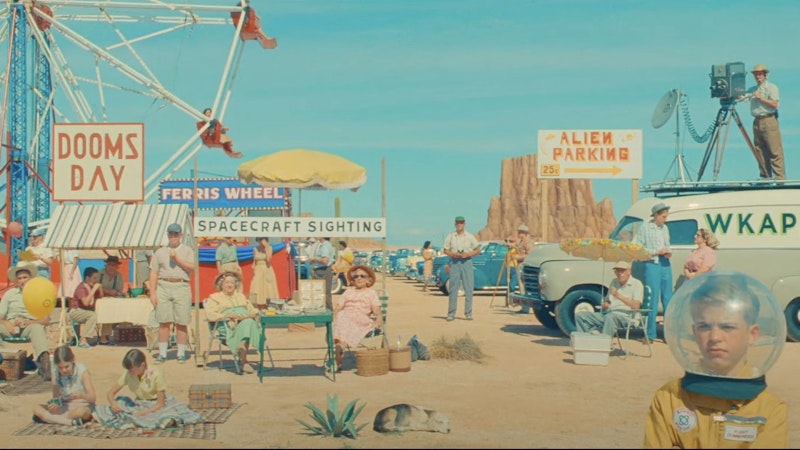On Thursday night, I ran into a friend at a revival of Taxi Driver at The Charles. Jawing for 15 minutes before the movie started, we went through the usual hopscotch litany of cinema obsessive conversations (Favorite Antonioni? Red Desert or Zabriskie Point. Top of the pantheon? All About Eve and On the Waterfront—although I don’t agree. Babylon? “A piece of shit.”) And then there were new releases: one theater over, Wes Anderson’s 11th feature, Asteroid City, was having its first Baltimore screenings. I tried to go to the bathroom during Robert De Niro’s first conversation with Harvey Keitel the pimp, but it was packed, a steady stream coming out of Anderson’s pastel teleplay exercise (I tried again during the one scene in the movie that’s not from De Niro’s perspective, Keitel and Jodie Foster alone in the hotel).
My friend was looking forward to Asteroid City, and that its enormous ensemble all-star cast was most reminiscent of the disaster epics of the 1970s: not even Airport, The Towering Inferno, The Poseidon Adventure, or Rollercoaster had as many “names” as Anderson’s latest. As soon as the 4:3 black and white television framing device ends, the movie opens up in Scope, vivid pastels covering an orange desert, and the endless star roll begins: Adrien Brody, Jason Schwartzman, Tom Hanks, Liev Schreiber, Hope Davis, Jeff Goldblum, Maya Hawke, Matt Dillon, Margot Robbie, Hong Chau, Steve Carell, Scarlett Johansson, Bryan Cranston, Tilda Swinton, Fisher Stevens, Edward Norton, Bob Balaban, and many more… unfortunately, despite Goldblum, this ain’t Nashville.
Asteroid City has one of the most enormous gulfs between its style and its substance I’ve ever seen in a film. Sixteen years after The Darjeeling Limited, an okay movie that at least had a real story, Anderson is back in the desert, but this time it’s not India for India, it’s Spain for the American Southwest. No qualm here: God knows how many superb Westerns were shot in Almería and Sorrento, just over the border—but when Sergio Corbucci made his “mud and blood trilogy,” he didn’t just stick Franco Nero or Klaus Kinski in a free-for-all massacre. What’s so frustrating about Asteroid City is how developed its world is, and how devoid it is of anything to hold onto. I loved Anderson’s previous film, The French Dispatch, because it felt like a major development for him: however politically naive it may be, its horror vacui tableaux were unlike anything else in contemporary American cinema.
But here? What’s there to hold onto? Anderson has his huge cast, his tics, and his general sensibility, which really isn’t that sophisticated. I don’t care that his knowledge of French politics and history appears entirely gleaned from the films of François Truffaut, and I can take his characters’ quirky deadpan delivery depending on the movie, but when you have nothing compelling, nothing exciting, nothing happening, what’s the point? The Towering Inferno was produced, promoted, and received as a massive commercial blockbuster, hardly a personal film at all—but I’ll sooner revisit that than Asteroid City; at least that movie has Jennifer Jones, in her final role, falling out of a skyscraper! Asteroid City is a beguiling film I can’t quite call Anderson’s worst, but one which lays out his worst qualities in brutal, dull detail, a vivisection of a body filled with frosting and little else.
—Follow Nicky Smith on Twitter: @nickyotissmith

